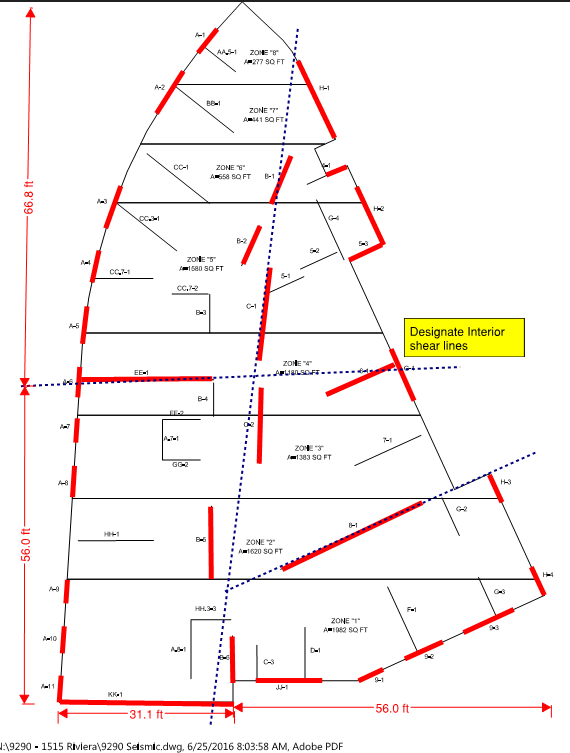I am designing a wood frame structure with non-parallel shear walls. I am trying to determine how to distribute forces to the skewed shear wall. Below is an example of what I think I can do:
On one line of resistance, I have a 10' long wall (plywood shear wall) at 0 degrees and another 10' long wall at 30 degrees. My thought is to divide the skewed wall into orthogonal components (8.66' in the 0 degree direction and 5' in the 90 degree direction). If I apply a 5000 lb load to this line of resistance, my unit shear would be v = 5000 lbs / (10' + 8.66') = 268 lbs/ft. In the skewed wall, I will have F = 268 lbs/ft x 8.66' = 2321 lbs.
And then I would analyze the structure in the orthogonal direction and come up with a similar unit shear. In the orthogonal direction, I have a 10' long wall at 90 deg and the same 10' long wall at 30 deg. If I have the same 5000 lb load, my unit shear would be v = 5000 lbs / (10' + 5') = 333 lbs/ft. In the skewed wall, I will have F = 333 lbs/ft x 5' = 1665 lbs.
Lastly, I would combine these using the 100% + 30% rule. So I would have: F = 1.0 x 2321 + 0.3 x 1665 = 2821 lbs and F = 1.0 x 1665 + 0.3 x 2321 = 2361 lbs. Using the controlling 2821 lbs in this wall, the unit shear in the skewed wall will be v = 2821 lbs / 10' = 282 lbs/ft.
Does this seem correct?
Thanks for any advice!
On one line of resistance, I have a 10' long wall (plywood shear wall) at 0 degrees and another 10' long wall at 30 degrees. My thought is to divide the skewed wall into orthogonal components (8.66' in the 0 degree direction and 5' in the 90 degree direction). If I apply a 5000 lb load to this line of resistance, my unit shear would be v = 5000 lbs / (10' + 8.66') = 268 lbs/ft. In the skewed wall, I will have F = 268 lbs/ft x 8.66' = 2321 lbs.
And then I would analyze the structure in the orthogonal direction and come up with a similar unit shear. In the orthogonal direction, I have a 10' long wall at 90 deg and the same 10' long wall at 30 deg. If I have the same 5000 lb load, my unit shear would be v = 5000 lbs / (10' + 5') = 333 lbs/ft. In the skewed wall, I will have F = 333 lbs/ft x 5' = 1665 lbs.
Lastly, I would combine these using the 100% + 30% rule. So I would have: F = 1.0 x 2321 + 0.3 x 1665 = 2821 lbs and F = 1.0 x 1665 + 0.3 x 2321 = 2361 lbs. Using the controlling 2821 lbs in this wall, the unit shear in the skewed wall will be v = 2821 lbs / 10' = 282 lbs/ft.
Does this seem correct?
Thanks for any advice!

